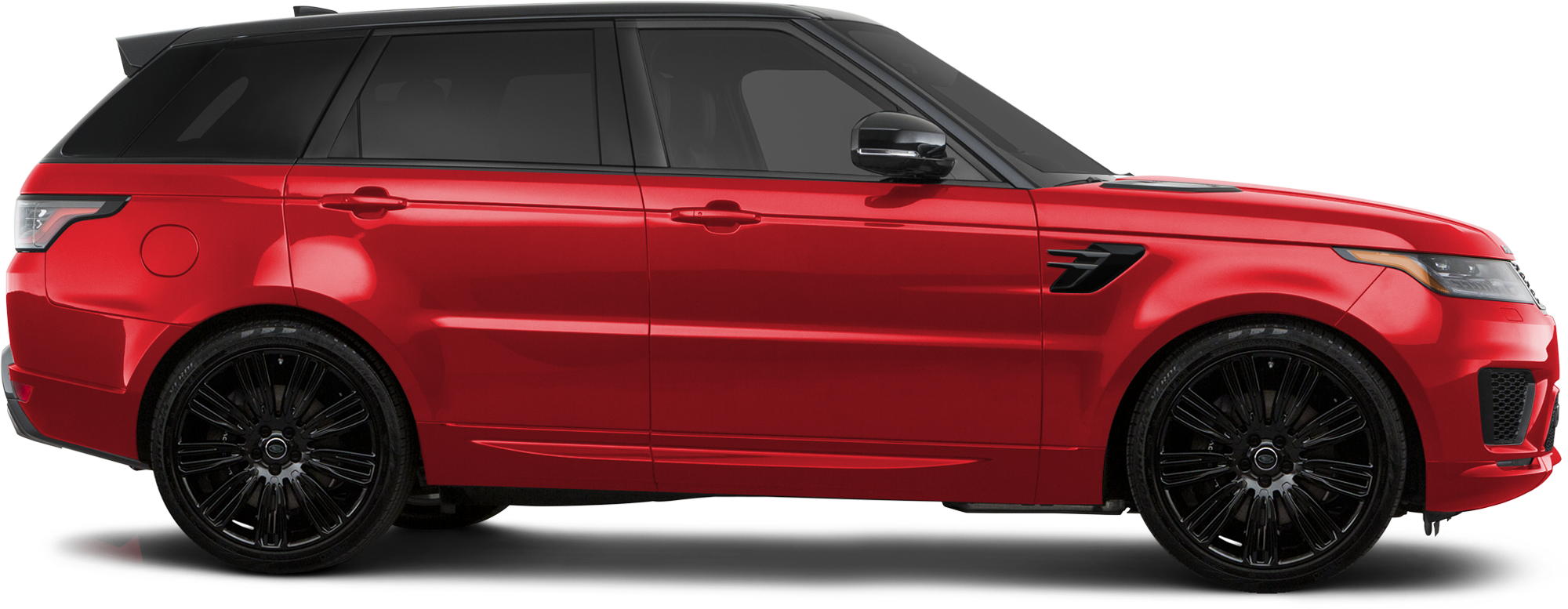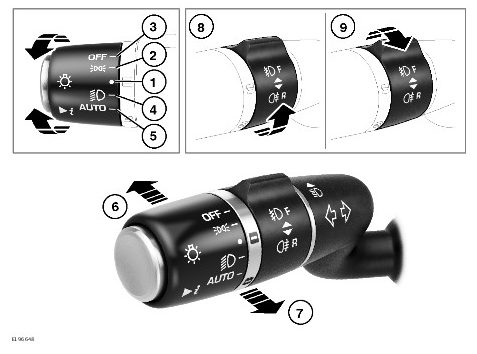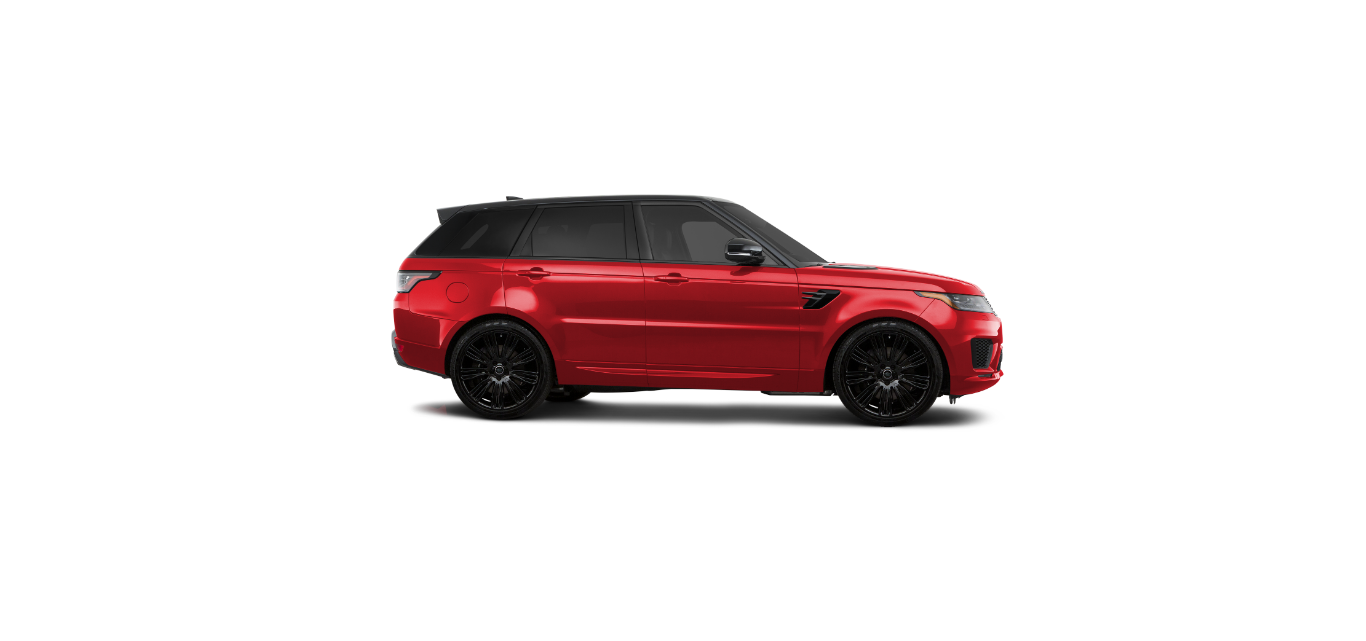2022 Land Rover Range Rover Sport Exterior Lights

LIGHTING CONTROL

- The neutral position of the lighting control: The lighting system operates automatically, dependent on the ambient level of light. During daylight, the Daytime Running Lights (DRL) automatically switch on. During night time the headlight switches on automatically. Rotate the lighting control to the required position and release, it to manually switch on any lighting functions. When released, the lighting control returns to the neutral position.
- Side lights: Rotate the lighting control to this position to switch the side lights on. The instrument panel warning lamp illuminates. See SIDELIGHTS (GREEN).
- Headlights OFF: Rotate the lighting control to this position to switch the headlights off.
- Headlights: Rotate the lighting control to this position to switch the headlights on.
- AUTO: Rotate the lighting control to this position to select auto lights. Selecting AUTO causes the lighting system to operate according to ambient conditions. Headlight courtesy delay, Auto High Beam Assist (AHBA), and wiper detection may also be activated.
NOTES
Do not use a high beam where it may distract other road users.
- High beam: With the headlights on, push and release the lighting control to select the high beam. Push and release the lighting control again to deselect the high beam. The instrument panel warning lamp illuminates. See HIGH BEAM (BLUE).
- High beam flash: Pull the lighting control toward the steering wheel and release it to flash the high beam on and off. The high beam remains on for as long as the lighting control is held.
NOTES
Low exterior light levels, caused by adverse weather conditions, may also cause the auto lights to activate.
- Front fog lights: Turn the lighting control away from the steering wheel, and release it to switch off the front fog lights. Turn the lighting control away from the steering wheel again, and release to switch off the front fog lights. The instrument panel warning light illuminates. See FRONT FOG LIGHTS (GREEN).
- Rear fog lights: Operate only while the headlights or front fog lights are selected. Turn the lighting control toward the steering wheel, and release to switch on the rear fog lights. Turn the lighting control toward the steering wheel again, and release it to switch off the rear fog lights. The instrument panel warning lamp illuminates. See REAR FOG LIGHTS (AMBER).
In the event of a bulb failure, it should be noted that some bulbs are replaceable only by a retailer/authorized repairer. See CHANGING A BULB.
DAYTIME RUNNING LIGHTS (DRL)
During normal daylight operation, the Daytime Running Lights (DRL) operate automatically, with the lighting control in the AUTO position.
The DRL switch on automatically under the following conditions:
- The engine is running.
- The gear selector is out of Park (P).
- The Electric Parking Brake (EPB) is not applied. Market dependent.
- Auto lights are selected and high ambient light levels are detected.
Turn the lighting control to the OFF position to switch off the DRL. The DRL can be manually switched off only when the vehicle is stationary and the engine is running. Repeat the process to switch off the DRL during a journey.
HEADLIGHT COURTESY DELAY
Headlight courtesy delay operates whenever the lighting control is in the AUTO position and the ignition is switched off. The headlights remain illuminated for up to 4 minutes.
The time delay may be changed via the Vehicle settings menu. See INSTRUMENT PANEL MENU. Press the headlight button on the smart key to switch off courtesy lights at any time.
AUTO HIGH BEAM ASSIST (AHBA)
The Auto High Beam Assist (AHBA) system cannot be relied upon to activate or deactivate the high beam in all possible circumstances. The driver remains responsible for the correct use of the headlights at all times. Incorrect use of the headlights may cause injury or death.
The forward-facing sensors are mounted on the rear of the rear-view mirror. Keep this area of the vehicle clean and free from obstructions, e.g., stickers, debris, mud, snow, or ice. Failure to do so can lead to accidents causing serious injury or death.
The AHBA feature is a reactive system, not a predictive system. Its automated function relies on a clear view of other vehicle light sources, at which point the system will react. The AHBA system automatically disables high beams in the presence of other road users and street-lit environments, enabling the high beams in their absence. The system is only active when the ambient light drops below a predetermined level. AHBA is enabled when the lighting control is in the AUTO position and AHBA is selected within the instrument panel.
The driver can disable and re-enable the AHBA system at any time as follows:
- Select Exterior lighting in the Vehicle settings menu, via the instrument panel. See INSTRUMENT PANEL MENU.
- Select Headlights high beam.
- Select Auto High Beam ON or OFF.
The AHBA system only activates when the vehicle’s speed exceeds 25 mph (40 km/h). The system deactivates when the vehicle’s speed drops below 15 mph (24 km/h). Push and release the lighting control to manually override to low beam from the high beam. Rotate the collar to AUTO to return to AHBA. The instrument panel warning lamp illuminates. See AUTO HIGH BEAM ASSIST (AHBA) (WHITE). Push and release the lighting control to manually select the high beam. Rotate the lighting control to AUTO to return to AHBA.
The following situations may limit the performance of AHBA:
- Highly reflective road signs.
- Highly reflective vehicles, e.g., brightly colored and emergency service vehicles.
- Dimly lit road users, e.g., cyclists or pedestrians.
- Adverse weather conditions, e.g., rain or fog.
- A dirty or obscured sensor.
- A dirty, damaged, or misted windshield.
- Oncoming vehicles, partially obscured by a central highway barrier.
- An icy or frosted windshield.
EXTERIOR LIGHTS CONDENSATION
- Condensation in the headlights, turn signals, or rear lights are a natural phenomenon.
- Condensation can occur under certain atmospheric conditions or after washing the vehicle.
- The performance and life expectancy of the lights are not affected.
- Condensation should partially or completely clear, with regular use of the lights, within 48 hours of dry atmospheric conditions.
- LED lights distribute less heat toward the outer lens than halogen or xenon lights. In extreme conditions, LED lights may take longer to clear, but this is not detrimental to the performance of the light.

